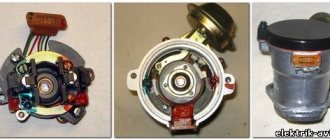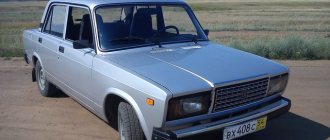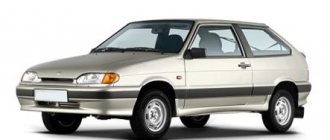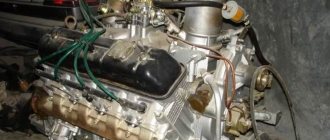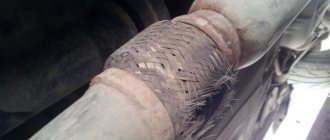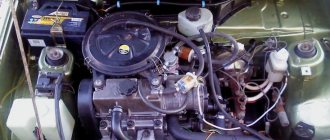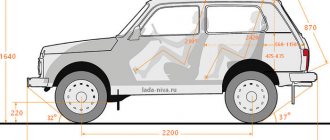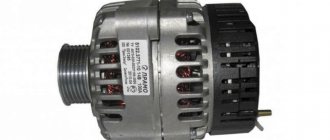The VAZ four-cylinder petrol engine with a displacement of 1.3 liters, which was installed on VAZ 2105 cars, has established itself as a fairly reliable, economical and easy-to-use power unit. The VAZ 2105 engine appeared in 1979 and, with minor changes, was able to last on the assembly line until 2006. Initially, this power unit had a carburetor power system, but later received a reliable injector, which made it possible to significantly increase engine power.
Design
VAZ-21053 is the progenitor of the “seven”. Externally, it is very similar to the VAZ-2107, with the exception of the radiator grille. It became the first model in which they strongly decided to abandon chrome (in order to reduce the cost of the design). Thus, the radiator grille was completely black, and the shiny moldings usual for the “Classics” were absent on the body. Other differences include new rectangular headlights with integrated turn signals. Also, other bumpers appeared on the “five”. They were also metal, but more voluminous and lacking “fangs”.
The design of the front side windows has also changed. Previously, the Classic had windows. With the advent of the “five”, the door received solid glass. The design of the rear lights has changed. Otherwise, the body structure remains the same. By the way, initially only 13-inch stamped wheels were offered for the Zhiguli. In the 2000s, 14-inch alloy wheels became available for the VAZ-21053.
Among the disadvantages of this car, owners note the quality of corrosion protection. The car is rotting badly. Therefore, it is not surprising that the “five” could be repainted several times. And touch-ups are completely normal for her. The weak points of the “five” are the sills, bottom and arches. There is no protection against corrosion here. In order to somehow protect against rust, the owners themselves coat the bottom with mastic, treat the thresholds with anti-gravel and other means. Plastic fender liners are also often installed on the car.
Recycling program
The car was not in demand, and the manufacturer had already begun to suffer losses. The situation was smoothed out after the introduction of a recycling program, when the owner of an old car received 50,000 rubles from the state as compensation for melting it down. During this period, all AvtoVAZ models, including the VAZ-21053, again became in demand. Prices rose, and then a balancing act began between the cost of the scrappage certificate and the market value of the car. This continued until the model was removed from the assembly line (2009).
We recommend: German ZF gearboxes on KAMAZ trucks
Why did the car attract buyers, albeit few? First of all, the availability of spare parts and components, which were relatively inexpensive. In addition, the attractiveness of the VAZ-21053 for Russians was the possibility of repairing and servicing it on their own (in the garage, on the site, or simply “in the field”). This circumstance somewhat leveled out the low demand for the car, but its prestige on the world market fell hopelessly. The car was no longer equipped with even the most necessary accessories; it got to the point that at the beginning of 2009, the daily mileage counter was removed from the dashboard.
Tuning
Recently, the “stens” movement has become increasingly popular. So, the owners tune the VAZ-21053 by installing:
- Classic alloy wheels with a wide shelf.
- Arch extensions.
- JDM style mirrors (placed on the hood).
- “Lips” in the front of the car.
- Spoiler in ducktail style.
The reader can see what the Soviet “five” looks like after this tuning in the photo below.
This car really attracts attention.
Brake system
The VAZ-21053 model was equipped with efficient dual-circuit hydraulics. From the central brake cylinder, pressure was supplied to the front and rear wheels according to a separate scheme. One pipeline connected the cylinder to the left front and right rear wheels, and the other connected the left rear wheel to the right front. This separation provided braking in case of failure of one of the circuits.
The front brakes, non-ventilated disc pads, were driven by a caliper covering the brake disc on both sides. The pistons were equipped with special rubber sealing rings that returned them to their original position after each press on the brake pedal.
The rear brakes, drum type, consisted of two self-adjusting shoes, driven by a hydraulic cylinder. The pads returned to their original position under the action of a spring. The design also included a handbrake mechanism controlled from the interior. The handbrake lever was located in the cabin, between the front seats.
VAZ-21053: dimensions, ground clearance
By European standards, the car belongs to the B-class. Thus, the total length of the body is 4.13 meters, width – 1.62, height – 1.45 meters. But it must be said that the length of the wheelbase (2424 millimeters) is very modest even for the B-class. At the same time, the car has impressive ground clearance. On standard 13-inch wheels its size is 17 centimeters. Some owners even raise the rear end. But basically this is not done for cross-country ability (after all, even with standard ground clearance the vehicle could confidently “force” the dirt road), but with the aim of increasing the load capacity. The suspension was very soft and when heavily loaded the rear part sagged a lot.
Inexpensive AvtoVAZ model
In 2008-2009, the car was considered the cheapest on the Russian market. For reasons of market conditions, prices were steadily declining, since the demand for the car was insignificant. Its popularity was not helped by its ascetic equipment and lack of accessories that make the car a comfortable means of transportation. In addition, during that period the VAZ-2107 model appeared - a direct competitor to the “five”. Since the unification was almost one hundred percent, it was decided to produce only one of them - the VAZ-2107.
Salon
Inside, the car looks the same as the “four” and “seven”. The driver has a four-spoke steering wheel without any adjustment and a flat fabric seat. The instrument panel on the VAZ-21053 is a pointer panel with modest backlighting. Nevertheless, everything necessary was located here: speedometer, tachometer, fuel level and antifreeze temperature sensor.
By the way, the “five” became the first car among the “Classics”, which was standardly equipped with a heated rear window. In addition, the front door windows have been ventilated in the cabin. However, in order to place deflectors in the panel, it was necessary to reduce the already small-sized glove compartment. The interior here is so simple that the only electronic items are interior lighting and rear window heating. All window regulators are mechanical. The seats are manually adjustable. Among the shortcomings in the interior, the owners note:
- Poor sound insulation. It is very noisy inside, especially at speed, when the roar of the engine can be heard from under the hood.
- Uncomfortable seats. Although they received height-adjustable headrests, they were extremely uncomfortable. There was no lumbar and lateral support. In addition, the seats quickly sank and rubbed. Because of this, you could often see covers on the seats of Zhiguli cars.
- Bad ergonomics. In particular, this concerned the steering wheel and inconvenient controls on the stove.
DIY repair
If you want to overhaul the engine yourself, pay special attention to the marks, which are needed even for ordinary simple operations, such as adjusting valves. Marks also allow you to correctly install certain parts and components. A diagram or a detailed video, which you will find at the end of the article, will help you in your work. Regardless of the simple device, the VAZ 21053 engine must be assembled as accurately as possible. Of course, the engine should be repaired on a clean workbench so that particles that accelerate wear do not penetrate inside.
Remember that in some cases the markings are applied to the parts incorrectly, so even if the marks are compared, unstable operation of the unit may be observed. In this case, the part should be replaced or contacted by specialists with high-quality diagnostic equipment. You can always consult with experienced owners of VAZ 21053 cars, who should know the structure and features of repair work.
Sources
- https://www.syl.ru/article/398875/vaz—foto-i-opisanie-tehnicheskie-harakteristiki-tyuning
- https://Driving24.ru/tyuning-i-kapitalnyj-remont-dvigatelya-vaz-21053-chto-vybrat/
- https://pochiniavto.ru/vaz/21053/
- https://FB.ru/article/154809/vaz—tehnicheskie-harakteristiki-otzyivyi-foto-tsenyi
Technical characteristics of VAZ-21053
This modification could be equipped with several engines. Initially, the VAZ-21053 was equipped with a carburetor engine from the Troika. It was an eight-valve one and a half liter engine with a timing chain and a power of 72 horsepower. Torque – 104 Nm. The gearbox could be different. At first, the “five” was equipped with a four-speed manual, and then with a five-speed one.
In 2000, the carburetor engine was replaced with an injection engine. So, under the hood of the “classic” there was a “four” engine with distributed injection. With a volume of 1.5 liters, it developed the same 72 horsepower. However, the torque has increased. Now it is 110 Nm. Also, the power unit began to comply with the Euro-2 environmental standard. There was no alternative mechanics offered as a transmission. As experience in operating the VAZ-21053 shows, the box began to howl over time due to the bearings. But this was not considered a serious disadvantage.
Among the main disadvantages of the Zhiguli, the owners noted poor acceleration dynamics. Depending on the type of engine and gearbox, the “five” accelerated to hundreds in 17-20 seconds. The maximum speed ranged from 142 to 150 kilometers per hour. At the same time, the car was voracious. The classic engine consumed an average of 10 liters of 92-grade gasoline per 100 kilometers. Moreover, on the highway this consumption did not drop significantly, due to the “brick” aerodynamics.
The engine had the same shortcomings as other Zhiguli engines. These are rapid wear of the camshaft, the need to adjust the valves, increased oil consumption, problems with the ignition system, etc. With proper maintenance, the engine life before major overhaul was about 180 thousand kilometers.
Why are modifications difficult?
Increasing the power of a belt-driven motor is much more difficult. For example, when using a humped camshaft, you have to install a split gear. For a 5 engine, it simply does not exist with a belt, that is, you will not be able to set marks. In this case, it is better to change the entire engine or install a conversion kit on the injector.
It is reasonable to carry out deep tuning of the VAZ 21053 engine only for certain creative reasons. Simple modifications to the machine with your own hands can be done without significant financial costs.
For example, if a car engine gets very hot, you can upgrade the power system. At the same time, you will be able to achieve reduced fuel consumption.
Before starting work, you should carefully study the recommendations of professionals and draw up an approximate tuning budget, as well as create an estimate of parts. It is important to determine where the parts are marked and where the marks are. Quite often it turns out that the accumulated money is not enough. Everyone should understand why this happens. When disassembling a vehicle, it usually turns out that it is necessary not only to modify the engine, but also to overhaul the main parts of the body. Also, before performing work, get a diagram or repair book. Regardless of the fact that the markings may be different for different units, you can use the literature for different Zhiguli models.
We recommend: Why the engine does not warm up to operating temperature
Chassis of the “five”
It is almost similar to other classic VAZ models. Thus, an independent spring suspension with transverse swing arms was installed on the front of the car. There is also a stabilizer bar at the front. At the rear there is a spring dependent suspension with longitudinal and transverse bars. The brake system is hydraulic, dual-circuit, with a vacuum booster. Disc brakes are installed at the front, drum brakes at the rear. The handbrake is mechanical, with drive to the rear wheels.
As reviews note, the suspension on the “five” is very soft. It is able to dampen vibrations even at high speeds. But at the same time, the suspension did not tolerate sharp impacts. Due to breakdowns, owners were faced with deformation of the axles of the lower arms. Also, due to the excessively soft suspension, the car took turns poorly and was practically uncontrollable at high speeds. Reviews include all hinge joints as weak points in the chassis. These are steering rods and ball joints. The shock absorbers quickly became unusable due to the large suspension travel. Also, due to low-grade metal, wheel bearings have to be replaced frequently.
Malfunctions
| FAULTS | CAUSES |
| A dull knock and loss of engine power. | A similar problem is typical for a broken timing belt. At the same time, the special design of the motor protected the valves from damage when the timing belt broke. In this case, the driver needed to replace the rollers and the belt itself. Often such repairs were enough to eliminate the problem. |
| Valve knocking when revs increase. | Service work on this engine required frequent valve clearance adjustments. If knocking occurs, you need to visit a service center or adjust the valve clearance yourself. |
| VAZ 2105 engine wedge with damage to valves and pistons. | Such breakdowns were usually caused by a lack of quality car maintenance, in which the car owner ignored the requirements for changing the oil. Repair in this case is high cost, since it is necessary to replace damaged valves, cylinder heads, pistons and crankshaft. |
| The motor overheats quickly. | There may be several reasons for this problem. This is a failure of the mechanical pump, insufficient coolant level, or the cooling radiator is dirty. |
Reviews
Reviews of the VAZ-21053 model have never been enthusiastic. The owners noted shortcomings in the gas distribution system. The camshaft belt drive, which often failed, caused a lot of criticism. During the period when the VAZ-03 and VAZ-06 engine with a chain drive was installed on the car, there were no such complaints.
If there are any positive reviews from car owners, they relate to the area of car repair and maintenance: all consumers note the relatively low prices for spare parts and the possibility of repairs in their own garage.
We're sorry, but the requests coming from your IP address appear to be automated. For this reason, we are forced to temporarily block access to the site.
To continue, please enter the characters from the image in the input field and click "Submit".
Cookies are disabled in your browser
. We will not be able to remember you and correctly identify you in the future. To enable cookies, follow the tips on this page.
